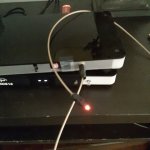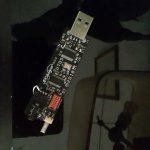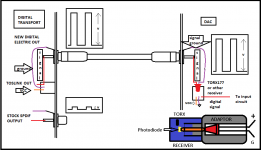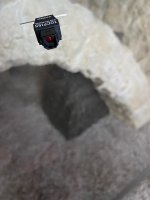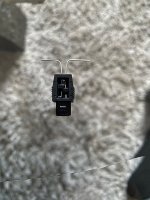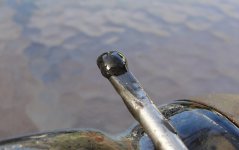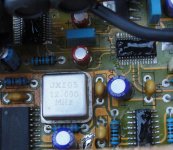I wonder how could I add and optic input to my MOSAIC DAC.
I bet a good transport would sound better than Rapsberry.
That was my point in comparing:
a) a RaspberryPi with the UTOS (John's current USB adapter) and ElectroTos interlink (after modding the UTOS)
b) the UPL (modded by John) and their ElectoTos interlink
Please note that I compared the two using both the MOS DAC at home and the Denafrips Terminator (6000$ retail) at a friend's house.
At this point, I can say that unfortunately you cannot expect miracles from a RaspberryPi as a source. Maybe a CD player would sound significantly better with the ElectroTos mod as you have done ? Not sure that would bring it to the level of what can be currently achieved with a UPL though...If it were the case, it would have escaped John ? Seems they have been very thorough in experimenting many solutions.
Reading back John's previous messages, we can understand that his upcoming solutions address this (but with their new DAC to get the full benefits).
Yes - peace and compasion !
Last edited:
Yes - peace and compassion !
I AM the Peace of the World.
I AM the Light of the World.
I AM one with the Source...and so ARE YOU, if you want.
a) a RaspberryPi with the UTOS (John's current USB adapter) and ElectroTos interlink (after modding the UTOS)
b) the UPL (modded by John) and their ElectoTos interlink
Thanks for sharing.
It would be nice if you could post some pics.
And I thought I was done with porn...
Best wishes,
M.
Here is a picture of the modded UTOS (not done professionally, unfortunately, but I put protective electrical tape around it), and the modded UPL with the ElectroTos cable supplied by ECDesigns. The modded UTOS can accept either regular toslink cable or ElectroTos using its small jack plug. Please note that they will offer, as they explained, a better designed cable with their next product line (RCA connector out, better Toslink in). P.S. on the back of the UPL there is a piece of scotch tape on the USB plug that is used for firmware update - just so I do not use it by mistake to recharge the UPL.
Attachments
Last edited:
Just to make it more clear and to remember the other option of Elektro-optik connection...
This is a mechanical sort of optimal solution. I do not claim to be a perfect technical/electric solution...the adapter has a small fiberoptic portion inside the shaft, the orange part.
This is a mechanical sort of optimal solution. I do not claim to be a perfect technical/electric solution...the adapter has a small fiberoptic portion inside the shaft, the orange part.
Attachments
Last edited:
I wanted to add a few comments. The thread talks a lot about DACs but we know that the promise of digital audio have not materialized so far also because of issues with the source and their connection to the DAC.
I am surprised that what ECDesigns have achieved, and what they have explained in recemt posts here has not gotten more attention, both from the DIY community and also from other manufacturers. Hope that will change soon.
I am surprised that what ECDesigns have achieved, and what they have explained in recemt posts here has not gotten more attention, both from the DIY community and also from other manufacturers. Hope that will change soon.
I wanted to add a few comments. The thread talks a lot about DACs but we know that the promise of digital audio have not materialized so far also because of issues with the source and their connection to the DAC.
I am surprised that what ECDesigns have achieved, and what they have explained in recemt posts here has not gotten more attention, both from the DIY community and also from other manufacturers. Hope that will change soon.
And you can add software to that too....
I don't though, my TDA1541 setup sounds very smooth, and analog.
Cheers,
Greg
Hi Maxlorenz, is this good choice of housing and Led diode?
TOCP155K Connector Simplex Plastic Black Toshiba Components
LED diode:
http://www.farnell.com/datasheets/2...06.1215280955.1585173544-656674753.1577497047
TOCP155K Connector Simplex Plastic Black Toshiba Components
LED diode:
http://www.farnell.com/datasheets/2...06.1215280955.1585173544-656674753.1577497047
Attachments
Hi Maxlorenz, is this good choice of housing and Led diode?
TOCP155K Connector Simplex Plastic Black Toshiba Components
LED diode:
http://www.farnell.com/datasheets/2...06.1215280955.1585173544-656674753.1577497047
I guess...just try it and see if it locks signal OK.
The mechanical grip must be tried into the receiver, I believe, before final assembly and soldering, because the internal structure of the receiver could limit the entry of the connector. In other words you may have to install the LED a little to the back back. It could be millimeters...
Remember, the signal must be higher the the standard 0.5V. Mine are +/-5V. Guess 3.3V could also work, if light power is enough, and or your receiver is sensitive.
Good luck,
M.
Hi JOSI1,
We are working on a number of new projects:
1) New digital audio interface that's compatible with DACs that have a Toslink input. I developed this new digital audio interface specifically for the connection with the DAC because I ran into unfixable problems with existing digital audio interfaces on the DAC.
2) USB translator for use with our new digital audio interface.
3) Toslink / Coax translator reclocker for use with our new digital audio interface.
4) New UPL24E with PC-based graphic user interface (apps for Linux, Mac, and Windows) and support for our new digital audio interface. Stand alone operation is still possible using the optional IR remote transceiver with built-in LED display.
5) New D/A converter, the D/A96TF. The design for this DAC was inspired by Fractals (ever repeating patterns that occur everywhere in nature).
The Fractal converters are totally different from the R2R and Mosaic converters and offer a number of advantages compared to existing D/A converter concepts. These Fractal converters have a true parallel data interface that feed the Fractal encoders in these converters. This ensures lowest possible clock and data rates and related lowest possible interference.
I used two 32 bit Fractal cores in the D/A96T
These Fractal converters run on a balanced +1V8, -1V8 power supply. DC-coupled output voltage equals 3V6pp and output impedance equals 375 OHms.
The converters are externally powered by a single 5V power source. Power consumption varies between 100 milliwatts @ 44.1 KHz to 200 milliwatts @ 96 KHz.
The complete DAC is located on two piggybacked circuit boards that form a compact 12 x 12 x1,5cm module.
I attached a sketch of the D/A96TF housing that measures approx. 15 x 15 x 2.5cm.
1) New digital audio interface that's compatible with DACs that have a Toslink input. I developed this new digital audio interface specifically for the connection with the DAC because I ran into unfixable problems with existing digital audio interfaces on the DAC.
I have the MOS16 and Mosaic T. I cant wait to buy your new digital audio interface.
John, how soon we should expect your new digital audio interface to be ready to purchase?
Hi youknowyou,
We hope to offer the U192ETL S/PDIF / ElectroTos translator and DA96ETF Fractal DAC in roughly 1 month.
These products will appear on our website as soon as these become available. Pre-orders (email) will have priority.
Specifications:
- USB bus powered (5V).
- Power supply CLC filters for bus noise attenuation.
- XMOS XU208 with built-in Flash program memory.
- Low jitter system and audio clocks (comparable with NDK), 24MHz, 22.5792MHz, 24.576 MHz. Each oscillator has separate RF supply noise filtering.
- Advanced synchroniser / driver circuit for XMOS jitter attenuation.
- Supports standard S/PDIF and ElectroTos low jitter protocol (jumper setting on the rear of the module).
- RCA (coax) output for driving the ElectroTos interlink (3.3Vpp).
- Power consumption approx. 500 milliwatts.
- ElectroTos interlink (supplied with module), 1 meter (39").
- Supports 44.1/16 ... 192/24.
- 160mm x 160mm x 30mm (6"x 6"x 1").
I attached sketches of the front and rear view. and a sketch of the planned ElectroTos interlink. The optical plug has integrated spring clamp mechanism that locks the connector into the Toslink socket and accurately aligns the ultra high speed LED with the optical receiver chip inside the Toslink socket. The LED wires are supported by the PCB. We use professional Hi Temp MIL spec coaxial cable.
I have the MOS16 and Mosaic T. I cant wait to buy your new digital audio interface.
John, how soon we should expect your new digital audio interface to be ready to purchase?
We hope to offer the U192ETL S/PDIF / ElectroTos translator and DA96ETF Fractal DAC in roughly 1 month.
These products will appear on our website as soon as these become available. Pre-orders (email) will have priority.
Specifications:
- USB bus powered (5V).
- Power supply CLC filters for bus noise attenuation.
- XMOS XU208 with built-in Flash program memory.
- Low jitter system and audio clocks (comparable with NDK), 24MHz, 22.5792MHz, 24.576 MHz. Each oscillator has separate RF supply noise filtering.
- Advanced synchroniser / driver circuit for XMOS jitter attenuation.
- Supports standard S/PDIF and ElectroTos low jitter protocol (jumper setting on the rear of the module).
- RCA (coax) output for driving the ElectroTos interlink (3.3Vpp).
- Power consumption approx. 500 milliwatts.
- ElectroTos interlink (supplied with module), 1 meter (39").
- Supports 44.1/16 ... 192/24.
- 160mm x 160mm x 30mm (6"x 6"x 1").
I attached sketches of the front and rear view. and a sketch of the planned ElectroTos interlink. The optical plug has integrated spring clamp mechanism that locks the connector into the Toslink socket and accurately aligns the ultra high speed LED with the optical receiver chip inside the Toslink socket. The LED wires are supported by the PCB. We use professional Hi Temp MIL spec coaxial cable.
Attachments
Hi youknowyou,
We hope to offer the U192ETL S/PDIF / ElectroTos translator and DA96ETF Fractal DAC in roughly 1 month.
These products will appear on our website as soon as these become available. Pre-orders (email) will have priority.
Specifications:
- USB bus powered (5V).
- Power supply CLC filters for bus noise attenuation.
- XMOS XU208 with built-in Flash program memory.
- Low jitter system and audio clocks (comparable with NDK), 24MHz, 22.5792MHz, 24.576 MHz. Each oscillator has separate RF supply noise filtering.
- Advanced synchroniser / driver circuit for XMOS jitter attenuation.
- Supports standard S/PDIF and ElectroTos low jitter protocol (jumper setting on the rear of the module).
- RCA (coax) output for driving the ElectroTos interlink (3.3Vpp).
- Power consumption approx. 500 milliwatts.
- ElectroTos interlink (supplied with module), 1 meter (39").
- Supports 44.1/16 ... 192/24.
- 160mm x 160mm x 30mm (6"x 6"x 1").
I attached sketches of the front and rear view. and a sketch of the planned ElectroTos interlink. The optical plug has integrated spring clamp mechanism that locks the connector into the Toslink socket and accurately aligns the ultra high speed LED with the optical receiver chip inside the Toslink socket. The LED wires are supported by the PCB. We use professional Hi Temp MIL spec coaxial cable.
Dear John,
Such a great news you've just shared with us!
We hope to get some news from you soon .. especially some pictures and informations concerning your coming DAC!
Best regards,
Ben
Great news, dear Guru.
Also great idea to use a small PCB to fix LED leads and wires.
I wanted to re-visit my favorite digital tweak.
I have commented previously,without much success to be completely honest ,about the wonders of organic varnish made of Linseed oil and turpentine to improve sound in woofers' cones, applied in summer to accelerate drying time.
,about the wonders of organic varnish made of Linseed oil and turpentine to improve sound in woofers' cones, applied in summer to accelerate drying time.
The same varnish with added graphite powder, "pencil grade" , does wonders for digital chips, meaning digital receivers, DACs, shift-registers, etc, provided you do not paint the leads...my last version, a 50/50 mixture of the above ingredients, was resting for eons under sun light, and now it is a thick and nice varnish,turpentine being evaporated. I put the unit belly up for some days until it completely dries. It can also be made on a 70/30 mixture to make it thicker and avoid long waits.
, does wonders for digital chips, meaning digital receivers, DACs, shift-registers, etc, provided you do not paint the leads...my last version, a 50/50 mixture of the above ingredients, was resting for eons under sun light, and now it is a thick and nice varnish,turpentine being evaporated. I put the unit belly up for some days until it completely dries. It can also be made on a 70/30 mixture to make it thicker and avoid long waits.
In case you do not like the effect, simply remove it when dried.
The effect on the MOSAIC UV was astounding. Organic, tight but expansive sound.
Cheers,
M.
Also great idea to use a small PCB to fix LED leads and wires.
I wanted to re-visit my favorite digital tweak.
I have commented previously,without much success to be completely honest
The same varnish with added graphite powder, "pencil grade"
In case you do not like the effect, simply remove it when dried.
The effect on the MOSAIC UV was astounding. Organic, tight but expansive sound.
Cheers,
M.
Attachments
I have commented previously,without much success to be completely honest ,about the wonders of organic varnish made of Linseed oil and turpentine to improve sound in woofers' cones, applied in summer to accelerate drying time.
Oops! In the hurry I forgot the principal ingredient: Dammar gum
Cheers,
M.
- RCA (coax) output for driving the ElectroTos interlink (3.3Vpp).
Ahrrgg...that's just a little over half of the (maybe nonstandard?) 2 VRMS output of normal DAC's.
MOS16/24 was also lower output.
Isn't it possible to raise the output level to the standard value??
That might be the difference between using passive or active preamps.
Another "complaint" with the MOS series was the single toslink input, and I am probably not the only one using multiple digital sources.
I understand that with the new coaxial interface it is possible to make a good quality switch box, so that is not so much of a problem, but as it is now also the new dac will be a bit limited in versatility.
Hi Max,
Did you try the graphite pencil grade alone on the chips but applied with the pencil directly ? same but no varnish to improve the cooling ? or an adhesiv paste made of thermal paste mixed with plenty of graphite powder hat may also allowing a copper hat grounded at the gnd pin of the chip ?
OT, while I believe the linseed double boiled oil that is typcaly used for wood being outside (all have not the luck to have auracaria tules ) or veenering has changed the Qts because the weight, what do you think about a sticky not-drying layer as for Dynaudio Esotar tweeter ? Targett : better damping and breaking mods !
) or veenering has changed the Qts because the weight, what do you think about a sticky not-drying layer as for Dynaudio Esotar tweeter ? Targett : better damping and breaking mods !
Asking myself about your original mixture on polypro cones for breaking their "muddy" sound due to break modes that polypro gives ? Could be very good too (or an usual organic/vegetal shellac instead linseed oil) !. Sorry for the OT.
Did you try the graphite pencil grade alone on the chips but applied with the pencil directly ? same but no varnish to improve the cooling ? or an adhesiv paste made of thermal paste mixed with plenty of graphite powder hat may also allowing a copper hat grounded at the gnd pin of the chip ?
OT, while I believe the linseed double boiled oil that is typcaly used for wood being outside (all have not the luck to have auracaria tules
Asking myself about your original mixture on polypro cones for breaking their "muddy" sound due to break modes that polypro gives ? Could be very good too (or an usual organic/vegetal shellac instead linseed oil) !. Sorry for the OT.
Last edited:
I guess...just try it and see if it locks signal OK.
The mechanical grip must be tried into the receiver, I believe, before final assembly and soldering, because the internal structure of the receiver could limit the entry of the connector. In other words you may have to install the LED a little to the back back. It could be millimeters...
Remember, the signal must be higher the the standard 0.5V. Mine are +/-5V. Guess 3.3V could also work, if light power is enough, and or your receiver is sensitive.
Good luck,
M.
Thank you maxlorenz
Best regards
Nedi
im confused about the electrotos interlink... is the U192ETL S/PDIF suited for the MOS16/Mosaic T DAC?Hi youknowyou,
We hope to offer the U192ETL S/PDIF / ElectroTos translator and DA96ETF Fractal DAC in roughly 1 month.
These products will appear on our website as soon as these become available. Pre-orders (email) will have priority.
Specifications:
- USB bus powered (5V).
- Power supply CLC filters for bus noise attenuation.
- XMOS XU208 with built-in Flash program memory.
- Low jitter system and audio clocks (comparable with NDK), 24MHz, 22.5792MHz, 24.576 MHz. Each oscillator has separate RF supply noise filtering.
- Advanced synchroniser / driver circuit for XMOS jitter attenuation.
- Supports standard S/PDIF and ElectroTos low jitter protocol (jumper setting on the rear of the module).
- RCA (coax) output for driving the ElectroTos interlink (3.3Vpp).
- Power consumption approx. 500 milliwatts.
- ElectroTos interlink (supplied with module), 1 meter (39").
- Supports 44.1/16 ... 192/24.
- 160mm x 160mm x 30mm (6"x 6"x 1").
I attached sketches of the front and rear view. and a sketch of the planned ElectroTos interlink. The optical plug has integrated spring clamp mechanism that locks the connector into the Toslink socket and accurately aligns the ultra high speed LED with the optical receiver chip inside the Toslink socket. The LED wires are supported by the PCB. We use professional Hi Temp MIL spec coaxial cable.
is there only one spdif toslink output?
what is the expected price?
thanks
Last edited:
Hi Max,
Did you try the graphite pencil grade alone on the chips but applied with the pencil directly ? same but no varnish to improve the cooling ? or an adhesiv paste made of thermal paste mixed with plenty of graphite powder hat may also allowing a copper hat grounded at the gnd pin of the chip ?
Good ideas, worth trying, especially pencil over tinny logic chips where varnish could be risky.
I believe that Dammar varnish has also especial effect, as the sound changes (improves) during the days it dries.
OT, while I believe the linseed double boiled oil that is typcaly used for wood being outside (all have not the luck to have auracaria tules) or veenering has changed the Qts because the weight, what do you think about a sticky not-drying layer as for Dynaudio Esotar tweeter ? Targett : better damping and breaking mods !
Asking myself about your original mixture on polypro cones for breaking their "muddy" sound due to break modes that polypro gives ? Could be very good too (or an usual organic/vegetal shellac instead linseed oil) !. Sorry for the OT.
I have not tried shellac.I do use other more stiffer gums mixed with Dammar which remains the main ingredient.There are two ways in which I have made this varnish: one is the usual disolving "à bain Marie"and the preferred slow dissolving through direct exposure to summer sunlight. I am not an organic chemist but I believe this method produces better characteristics by naturally modifying the terpenes, as commented by Fry (if I remember correctly) in his famous book about "Old Italian Violin Varnish"
I have never tried the varnish on tweeters (nor on polyprop) but I may on my test speakers.
I believe the added weight has lower effect (QTs?) than improved visco-elastic properties of treated paper woofers, probably the former varying linearly with added substance and the later varying non-linearly or exponentially(?) due to the improved mechanical properties of the cone, so it always did a good job IME. Curing time could be weeks though, depending on weather.
Cheers,
M.
Last edited:
- Home
- Source & Line
- Digital Line Level
- Building the ultimate NOS DAC using TDA1541A
